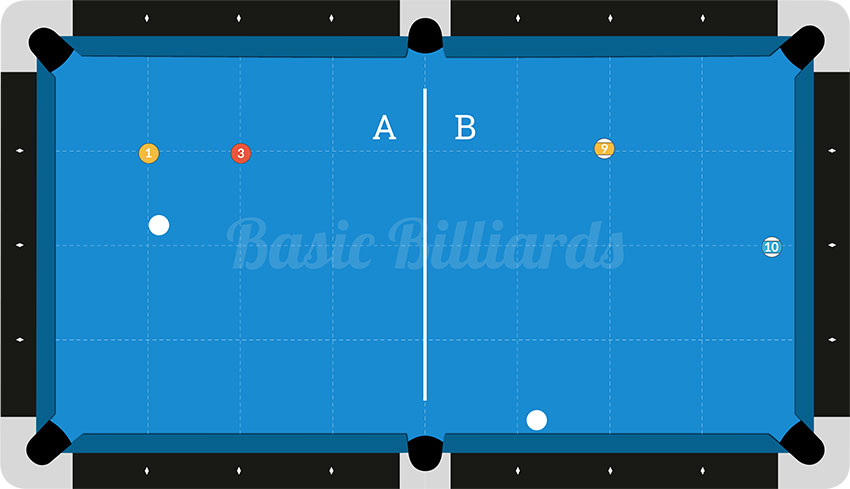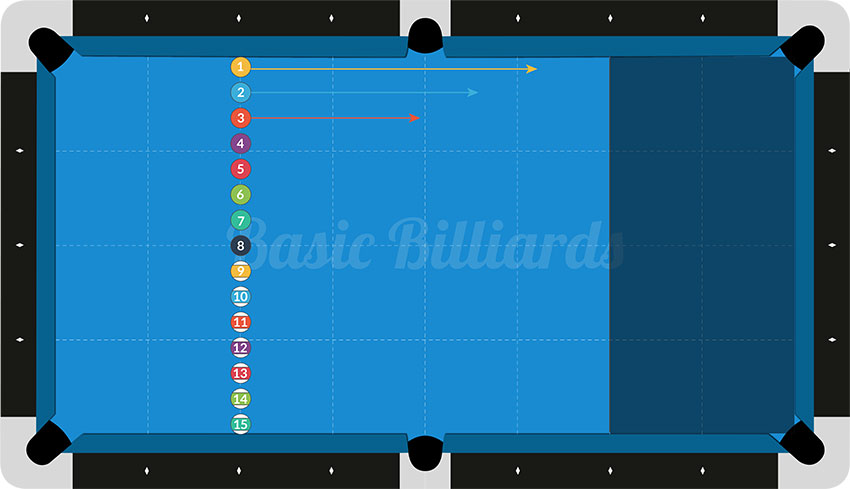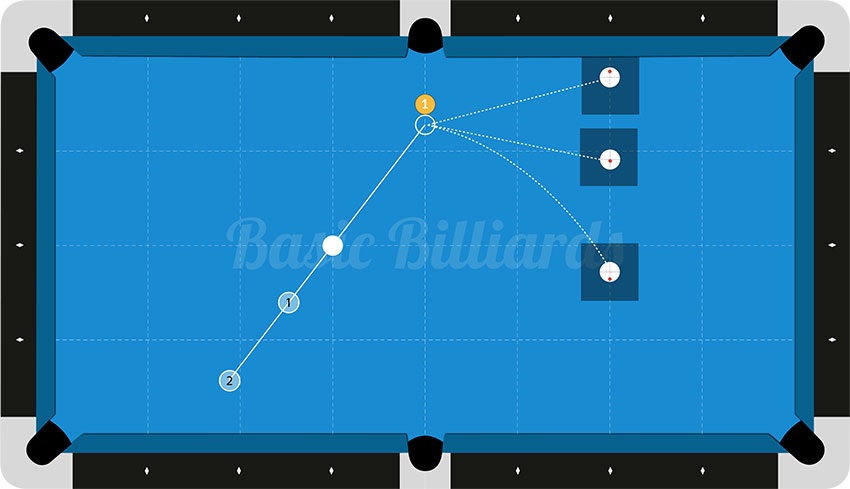Good position play is all about speed control with the cue ball. Speed control is what allows you to get the proper angle for your next shot and it puts the cue ball closer to the object ball making pool an easier game. Speed control isn’t easy, and it’s fair to say that most of the positional errors that people make are due to using the wrong speed. Errors in speed control result in bad angles on your next shot, getting hooked behind balls, or leaving yourself with too much distance.
Good speed control leaves the cue ball close to the object ball on the right angle to get good position for your next shot. The sweet spot for cue ball distance from the object ball is between 1 and 2 feet. Anything closer than that makes it difficult to use a clean stroke and aim at the same time. Farther away makes simple shots more challenging, especially when using English.

Figuring out what the correct speed for a shot is not always straightforward, especially when you consider that every pool table is unique. Minor changes in conditions can drastically change the speed of the table enough that on one table you would have had perfect speed and on another you’re a full diamond off course. So here are some examples of differences in equipment you can find on various tables:
Speed of Cloth
Worsted vs napped cloth: there are two types of cloth that are used for pool, worsted and napped. Worsted cloth is like a linen and is the kind of material you’d find on a suit. This type of cloth plays quickly, and most modern tables have this type of cloth. Napped cloth has little fibers that come out of the table which slows down the cue ball and it will fee l soft to the touch. You can’t see the fibers with your eyes, but you can feel them with your hand since the table will have a fuzzier feel to it.
Speed of the Rails
Tables with fast rails are often mistaken as tables with fast cloth when in fact, there is a difference. If you notice that you’re making shots with accurate speed when not using a rail vs using the rail it’s probably because the rails have a speed that you need to adjust to.
Humidity
This is a topic that’s touched upon frequently when you watch professional pool matches. The commentators often talk about how the TV table plays differently than other tables in the tournament because of the hot lights shining on the table for a good TV picture. The lights remove moisture from the cloth making the table dry which increases the speed of the table. You probably don’t have to worry about TV table conditions at your pool hall but even something as simple as turning on the air conditioning which puts moisture in the air can change the way your table plays. Bob Jewett, a professional pool instructor, tested the effect of humidity and table speed and found that a 20% increase in humidity resulted in at least a half diamond change in distance. That’s the difference between perfect position and accidentally hiding behind another ball!
Table care and cloth age
Over time as the cloth on a table gets older it tends to get dirtier too. After playing hundreds of games on one table, chalk and powder get embedded into the cloth and act like sandpaper on the cue ball which slows the cloth down as time goes on. A good way to delay this from happening is to clean and vacuum a table often.
In order to get used to a tables speed in a tournament it’s always a good idea to practice for at least a couple minutes on that table before a game. This will give you valuable information on how fast the table plays. Don’t worry if you can’t tell the difference between the speeds of different tables, overtime as you become a better and better player you’ll start to pick up on these small details and your control of the cue ball will increase.
A good way to increase your knowledge of speed control is to have a mental range of different speeds to use hitting the cue ball. When you just start out you’re only aware of a few different speeds to hit the cue ball: soft, medium, and hard. While this is ok as a starting point there should be more detail in your speed selection. For example, Phil Capelle, a fantastic instructional pool author, advises having a speed spectrum from 1-10. So instead of soft, medium and hard you should have a range that looks more like this:
- Very Soft
- Soft
- Somewhat Soft
- Light Medium
- Medium
- Medium Hard
- Hard
- Very Hard
- Extremely Hard
- Breaking Speed
This range give you much more information. Where the first level of speed, very soft is just fast enough to move the cue ball a diamond or so and the last level of speed is the kind of power you’d use on a break shot. The more you mentally use this spectrum of speeds the easier it will be to figure out how hard you need to hit the cue ball to get onto your next shot.
A great drill to practice your speed control is to set up 15 balls across the headstring. From here hit the first ball as softly as you can, then hit the next ball just hard enough that it goes past the ball you just hit. Keep doing this until you get to the last ball. The way it works is you should have to hit the balls hard and harder as you continue the drill which will help calibrate your speed control. This drill should only get you to around light medium speed so its a good way to get used to shooting slower shots.

Once you get the hang of that drill, you need to use progressive drills to progress your speed control. In the example drill below, the goal is to pocket the one in the side and put the cue ball in one of the three position zones. This will both help work on speed and spin, and it’s important to work on both since the type of spin you use will affect how hard you need to hit the cue ball. Once you get comfortable hitting those position spots move the cue ball farther away to make the shot more difficult.

Tip: A good way to mark your position zone is to put a blank sheet of paper on the pool table and aim to get the cue ball within that spot.
